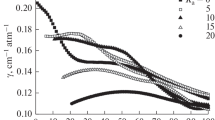Integral intensities of vibrational bands are calculated for hydrogen sulfide (H2S) taking into account the Fermi and Darling–Dennison resonances. Components of the dipole moment function in normal coordinates and parameters of the effective vibrational Hamiltonian borrowed from the literature are used as initial data. From several sets of the dipole moment function parameters, we have chosen the set of the parameters computations with which provide the closest agreement with the experimental integral intensities of the H2S bands. As a result, predictive computations of the vibrational band intensities (ΣΔυ i = 2) are carried out at temperatures in the range 600–1500 K.
Similar content being viewed by others
References
O. V. Naumenko and E. R. Polovtseva, Opt. Atm. Okeana, 16, No. 11, 985–991 (2003).
L. Legushat-Fossat, J. M. Flaud, C. Camy-Peyret, and J. W. C. Johns, Can. J. Phys., 62, 1889–1923 (1984).
L. R. Brown, J. A. Crisp, D. Crisp, et al., http://hdl.handle.net/2014/33910.
O. V. Naumenko and E. R. Polovtseva, Opt. Atmos. Okeana, 19, No. 8, 692–697 (2006).
M. T. Emerson and D. F. Eggers, J. Chem. Phys., 37, 251–259 (1962).
O. N. Sulakshina, Yu. G. Borkov, and Vl. G. Tyuterev, Opt. Atmos. Okeana, 14, No. 9, 753–761 (2001).
O. K. Voitsekhovskaya, Yu. S. Makushkin, N. N. Trifonova, and V. N. Cherepanov, Program of calculating centers and intensities of rovibrational lines of asymmetric top molecules, No. P004348, State Fund of Algorithms and Programs (1980).
A. D. Bykov, Yu. S. Makushkin, and O. N. Ulenikov, Rovibrational Spectroscopy of Water Vapor [in Russian], Nauka, Novosibirsk (1989).
O. V. Naumenko and E. R. Polovtseva, Opt. Atmos. Okeana, 17, No. 11, 791–794 (2004).
O. K. Voitsekhovskaya, Opt. Atm., 3, No. 6, 533–541 (1990).
A. Bykov, O. Naumenko, M. Smirnov, et al., Can. J. Phys., 72, 989–1000 (1994).
G. K. Speirs and V. Spirko, J. Mol. Spectrosc., 56, 104–123 (1975).
J. Senekowitsch, S. Carter, A. Zilch, et al., J. Chem. Phys., 90, 783–794 (1989).
T. Cours, P. Rosmus, and Vl. G. Tyuterev, J. Chem. Phys., 331, 317–322 (2000).
O. K. Voitsekhovskaya, A. V. Voitsekhovskii, D. E. Kashirskii, and I. S. Suslova, J. Opt. Technol., 77, No. 9, 37–44 (2010).
Author information
Authors and Affiliations
Corresponding author
Additional information
Translated from Izvestiya Vysshikh Uchebnykh Zavedenii, Fizika, No. 4, pp. 19–24, April, 2012.
Rights and permissions
About this article
Cite this article
Voitsekhovskaya, O.K., Egorov, O.V. Calculation of the intensities of vibrational hydrogen sulfide transitions for remote sensing of high-temperature media. Russ Phys J 55, 362–368 (2012). https://doi.org/10.1007/s11182-012-9820-7
Received:
Published:
Issue Date:
DOI: https://doi.org/10.1007/s11182-012-9820-7




